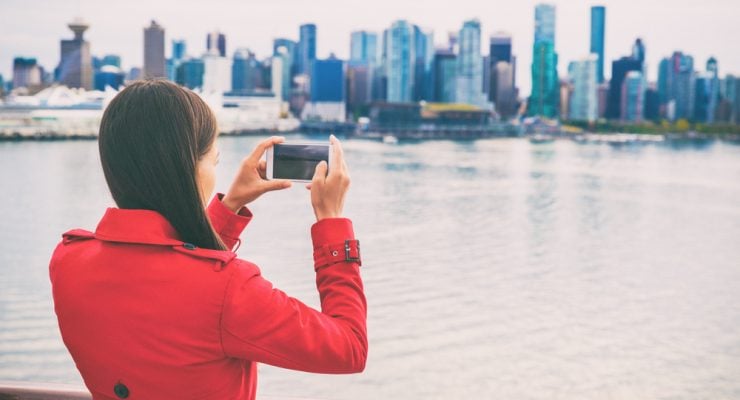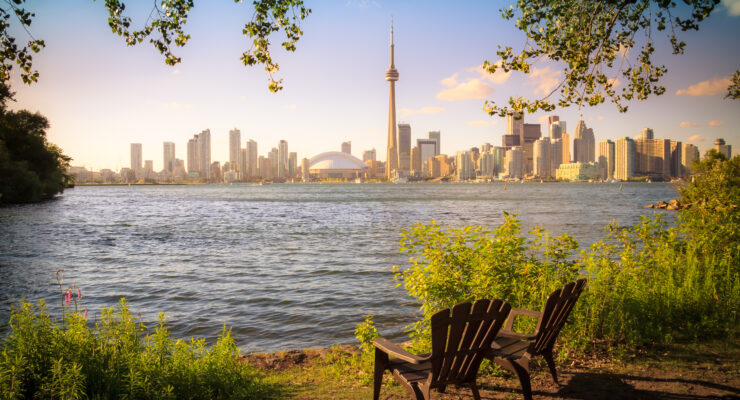Step-by-step pre-trip prep
Congrats on getting your WHP! Now that you know for sure you’re going to Canada, it’s time to adopt a methodical approach to complete a few important steps. You may want to read “Your To-Do List Before Going to Canada” for a more comprehensive overview.
Check your Electronic Travel Authorization (eTA)
As of March 15, 2016, visa-exempt foreign nationals who fly to, or transit through a Canadian airport, need an Electronic Travel Authorization (eTA). The Canadian eTA is much like the American ESTA (Electronic System for Travel Authorization). It takes a few minutes to apply and it costs $7. Those without an eTA will be denied entry.
As of August 1, 2015, the eTA is issued automatically if you’re approved for an IEC work permit (including a WHP) or a student permit. Therefore, you shouldn’t have to apply for your eTA. However, there are exceptions, including if you renew your passport after you receive your POE Letter of Introduction. Your letter is still valid but your eTA (issued automatically) isn’t. The eTA is linked to your old passport number, so you must apply for a new one.
Buy your plane ticket
There are plenty of flights, but finding the right plane ticket at the best possible price requires patience and dedication!
Overview of plane tickets types
If you fly to Canada with a one-way ticket, you can go anywhere you want at the end of your WHP. You can head home, fly to another country and you can leave from anywhere you want in Canada or elsewhere. This is the most flexible option if you have no idea where you will be and where you will be going a year from now—and what if you want to stay in Canada longer?
However, buying two one-way tickets is often more expensive than buying a round-trip ticket. Round-trip tickets are not mandatory with a WHP, but the border officer may ask to see a proof of sufficient funds on top of the required amount of $$2,500 amount to make sure you’ll be able to buy a return ticket. Showing $1,000 should be enough.
If you’re planning to stop somewhere on your way to Canada—for example, in the US—you can buy a multi-city ticket. Multi-stop flights allow you to visit two, three or more cities on one airfare and this type of ticket is usually cheaper than buying several one-way tickets separately.
A round-trip ticket is best for those who know they will arrive and leave from the same city. Return tickets are typically cheaper and you don’t have to worry about budgeting for your trip back home. However, they can be frustrating if you want to change your travel dates or if you decide to leave from another city.
You can also consider an open-ended ticket that sends you to a destination on a specific date, with a flexible return date. However, this type if ticket is typically more expensive and the return date has to be one year maximum from your departure date.
Booking online vs. Using a travel agency
For round-trip, one-day and multi-city tickets, you can compare flights, fares, routes and companies easily and complete the booking process quickly online.
However, for open-ended tickets, you will have to go to a travel agency. It’s also best to use professional travel agents for any special requirements you may have.
When should I book and travel to get the best deal?
There’s no magic formula to get the best deal. Generally speaking, it’s best not to wait until the last minute. You could get a great deal but most people who are going abroad for a year or two like to plan ahead (“The flight is tomorrow? OMG gotta pack!”)
It’s difficult to know how far in advance you should book to get the best deal. However, there are peak departure times and busy times of the year when tickets are more expensive. For example, it’s more expensive to travel to Canada in summer (it’s best to leave before or after school holidays) than in the dead of winter. Christmas, March Break, Labour Day and Thanksgiving are also busy days for air travel—tickets could be more expensive and flights tend to be full.
Book a place for your first few days
To start off on the right foot, it’s best to know where you’ll spend your first few nights in Canada. Some people commit to a rental before the trip while many others wait to arrive in Canada to see long-term accommodation options in person.
No apartment keys yet? Don’t worry, there are plenty of short-term options for a good night’s sleep.
Meet travellers in hostels or hotels
After a long flight, in the airport arrivals terminal, do you want to: 1) call all the hotels in your guidebook to see if a room is available? 2) wander around the city looking for a “hotel” sign? 3) head directly to the hotel you booked before leaving and recover from jet lag?
Yeah, one of these three options sounds… less exhausting!
There are plenty of hotels and hostels in all the main cities. Except for business hotels by the airport, they are usually conveniently located in the city core—it will make your life easier when you apply for a SIN, open a bank account, look for an apartment or a room, buy a vehicle, etc.
Hostels are typically the cheapest option. It’s also a great place to meet other travellers (including potential travel partners) and get useful tips. Most hostels offer a few private rooms (usually with shared bathrooms) and four-bed, eight-bed, and twelve-bed dorms. Dorms can be mixed or same sex only. Some hostels are huge and mostly focus on heads in beds—don’t expect any intimacy or a cozy couch by the fireplace.
Staying in a dorm is the cheapest option but it comes with a price—good luck with sleeping if the guy in the top bunk snores or if the rest of the girls barge into the dorm drunk at 2 a.m. If you value your sleep, avoid party hostels.
Hostels typically operate on an honour system. Travellers are expected to clean up after themselves and respect other people’s property. Many hostels offer lockers (bring your own lock so that you don’t have to buy or rent one). If there are no lockers, use common sense, don’t leave your valuables lying around but don’t be overly paranoid either—all the other travellers are in the same boat (or rather, in the same open dorm).
Here are a few points to consider when booking a hostel room or bed:
- The price
Most travellers have a tight budget, so price may be one of the most important factors affecting the decision. Just be careful, some deals are too good to be true. Very cheap hostels may be run down or far from everything.
- The location
Many hostels are in a convenient location like the downtown core or in popular neighbourhoods. You can’t go wrong with a downtown location—you’ll be within walking distance to shops, restaurants, bars, services, etc. It can make your job and apartment hunting efforts easier as well.
Hostels just outside the downtown core can be cheaper, quieter or offer a different accommodation style (an old house, for instance). If you choose to stay further from the action, make sure the public transit system is convenient and reliable and budget for your trips. Consider your options if you’re staying up late—can you go back to the hostel easily or will you have to take a taxi?
Remember that many in many North American cities, the geographical centre of the city isn’t always the most vibrant neighbourhood. Occasionally, these areas are lively during the workday but empty after 5 p.m. On the other hand, neighbourhoods that seem off-centre on the map can offer many employment opportunities as well as entertainments and accommodation options.
- The type of hostel
Hostels can be huge buildings with 16-bed dorms and a quick turnover of travellers. While they often offer an efficient check-in/check-out process and clean if sterile amenities, it’s hard to meet people and they lack a cozy, welcoming atmosphere. These hostels are often cheap and central.
It’s much easier to meet potential travel partners and make friends in smaller hostels. Groups of 20 or fewer travellers are more likely to get to know each other, cook together, have breakfast together and go out for a drink together. Your dorm mates won’t be strangers but people you’ll get to know. Travellers staying in smaller hostels are generally more open to social interactions—they aren’t just here to crash at night.
Meeting people is part of travelling. Whether you’re going to make a real friend, share a leg of the trip or just spend an evening chatting over a drink, these are moments you will remember—and many of these moments will happen in hostels!
- The reviews
Before you book your bed or your room, take a few minutes to read the hostel’s reviews. If the words “bed bugs,” “broken showerheads,” “dirty bathrooms” or “lumpy mattresses” come back too often, just avoid the place. Don’t forget to check if you’re booking a “party hostel”—it may be the kind of atmosphere you’re looking for but if you just want to relax and sleep, cross it off your list.
Be hosted for free with Couchsurfing
Couchsurfing isn’t just about crashing on someone’s couch for free—it’s a mindset, a lifestyle and a very active community of locals and travellers.
This is how it works. First, you have to join Couchsurfing for free and fill out a profile. Then, you can search for hosts in your destination city and read their profile. Some Couchsurfers open their homes, others simply offer to give you a city tour or chat over a drink—their availability is mentioned in their profile. Even if you’re mostly looking for a place to stay, do consider taking them up on these offers. When you’re new to a city, it’s great to get insider info and maybe get the chance to discover neighbourhoods that aren’t in your guidebook.
If you’re just looking for accommodation, make sure to contact a person who is accepting guests. On the host profile, you’ll also learn how many people can be hosted, which is good to know if you’re travelling as a couple or with friends. Finally, you can see if your host could be a good match by checking their occupation, interests, languages spoken, etc.
Once you find a host who meets your criteria, send an email. You will want to include your travel dates but try to be personal and friendly and introduce yourself briefly. Sending short copy-and-paste mass emails are more likely to be ignored so resist the urge to contact as many hosts as possible. If you do need to contact many hosts, personalize your first email. Think of it as a cover letter—mention a shared interest or a few details that made you want to contact this person.
Hosts will check your profile, so remember to fill it out and add a picture. You may not realize it, but hosts in popular destination cities are swamped with requests. Don’t be yet another anonymous wannabe Couchsurfer, stand out!
You can have your Couchsurfing account verified for $60. This is a one-time charge that allows members to verify their ID, phone number and address and grant them access to unlimited messages.
The verification process is simple—Couchsurfing sends you a postcard and a text message with a code to verify that your address and phone number is valid. When a member views your profile, they’ll be able to see if you have verified your phone number or location.
Note that you don’t have to be verified member to find members willing to host you as a guest.
As a Couchsurfing member, the community hopes that when you get the chance, you will also offer to host travellers on a small budget but with an open mind once you settle down somewhere or go back home. And if you can’t welcome people in your place, you may want to offer city tour or tips over a drink—there are many ways to keep the Couchsurfing community alive.
Both as a host and as a guest, the key words are meeting new people, discovering a destination with an insightful local and getting in touch with locals in an unfamiliar city.
Rent a room or an apartment directly from the owner though an online marketplace
If you don’t feel like sleeping in a dorm but can’t afford the hotel life where you have to eat out every night, consider booking a room or an apartment directly from a local owner. This is a great compromise to have some privacy but access to kitchen facilities and it’s a great deal if you’re travelling as a family or with friends.
You can find all kinds of properties for every budget on websites like Airbnb, Wimdu or Bedycasa, e.g. entire houses for rent, as well as condos and bedrooms. If you want to meet people, it’s best to rent a spare bedroom since your hosts will be around. Many condos are rented out by property management companies and operate like hotels—there are no full-time tenants.
All these online marketplaces offer some guarantees, like customer support, a messaging service between guests and hosts, and a comprehensive cancellation policy. You will get your money back if your host cancels your stay. Some hosts also offer a flexible cancellation policy if you need to change the dates of your stay or if you have to cancel your plans. Check the different policies before booking!
Choose the right luggage and pack smart
Not all backpackers carry backpacks and not all travellers pull a suitcase around—consider your budget and your plans before picking your luggage.
Pick out the right luggage
A suitcase offers more room than a backpack. It doesn’t put strain on your back and organizing the content is usually easier. If you’re leaning towards going to Canada with a suitcase or two, make sure to invest in quality. After all, you’re going to live out of your suitcase for a year or two, wheeled luggage with a broken wheel can ruin a trip.
A backpack is typically very sturdy and practical. It’s not the roomiest piece of luggage but you do keep both hands free. You don’t have to worry about uneven ground, snow banks and slush since you will do the walking. Make sure you’re comfortable carrying weight on your back, and find a practical and ergonomic packing system to access stuff easily and distribute weight evenly. Most backpackers put the heaviest load between a medium load at the bottom and a lightweight load at the top. Unless you’re planning to hike, a mid-priced backpack should offer enough quality and comfort for most travellers.
No matter what you choose, remember to “take half the clothes and twice the money.” If putting everything you may need for a year in a backpack or a suitcase feels like a challenging task, go step by step. Arrange everything you think you may need on your bed and consider every item carefully. Remember, you should be able to buy a pair of jeans or underwear in Canada if you really need it!
Suitcase vs. Backpack
Suitcase
How do I choose the right one?
- Take it for a spin and test the wheels. Is it rolling smoothly and easily?
- Check the zipper. Does it look sturdy?
- Choose the lightest model.
- Hard-shell suitcases offer the best shock protection, but they are generally much heavier and bulky. Lightweight hard-sided suitcases are typically pretty expensive.
- Softshell suitcases are lighter but they aren’t as protective or sturdy and most of the time the material isn’t waterproof. However, these suitcases are reasonably priced and offer good overall value.
Pick a model with inner pockets and straps to better organize the contents. - Consider investing in an extra strap to keep the suitcase closed during air travel. It can be a lifesaver it the zipper breaks (which does happen!)
Packing tips
Most airlines have a 20-kilo luggage allowance. Remember, this is an allowance, it doesn’t mean you must jam yours until it barely closes! Leave room for souvenirs and make sure you can lift it easily.
Backpack
How do I choose the right one?
- It’s easier to access your stuff with a front-loading backpack than with a top-loading backpack•
- Pick a design that feels comfortable on your shoulders. Always try several models (with a load in them!) before making a purchaseThere’s no point in buying an 85-litre monster if you can’t lift it, much less carry it.
- The differences between men’s and women’s backpacks are minimal (narrower shoulders for women backpacks, for instance). Pick the most comfortable one for you.
- Choose a model with pockets to organize the contents.
- Consider investing in a waterproof “rain cover” if you’re planning to hike or stay in a rainy destination.
- It can be a good idea to buy a separate strap to secure it.
Packing tips
- Distribute the weight evenly by putting the heaviest load in the middle.
- Buy a bigger backpack but leave some room. For instance, buy a 70 litre but use it as a 50-litre backpack.
Pack for airport security and customs
Airport security rules change fairly often and are more or less enforced depending on the country and on the security checkpoint. Let’s review the basic rules and see what you can and cannot bring into Canada.
Restricted and prohibited items
Carry-on and checked luggage: Flammable, explosive or toxic materials or items are prohibited. Generally, potentially harmful items are not allowed.
Carry-on luggage: Containers of liquids, non-solid food and personal items must be 100 ml/100 g (3.4 oz) or less. All containers must fit in one clear, resealable plastic bag no more than 1L in capacity. The bag must be transparent so screening officers can easily see the contents. Each passenger is allowed a single 1 L bag containing liquids, food and personal items.
Don’t put knives and lighters in your carry-on luggage. If found, they will be discarded at the security point—you won’t have to chance to go back to the check-in counter and beg to stuff your precious knife in your backpack.
If you’re taking medicine, bring your prescription.
Bringing food
It’s tempting to bring your favourite treats to Canada to share with new friends or to have as comfort food. Some foods are okay, some aren’t. Canada generally accepts food that’s commercially packaged and labelled. Read the page What Can I Bring Into Canada in Terms Of Food, Plant, Animal and Related Products? to make sure your cravings will make it through customs.
Note that products are restricted or prohibited entry because they can harbour foreign animal and plant pests and diseases. Restrictions are adjusted over time and they can be difficult to decipher. For instance, fois gras is okay as long as it’s canned, baked sausage rolls won’t be allowed (bacterial food poisoning risk) and a loose apple will be confiscated.
Travelling with medications
Passengers with medical needs are allowed to bring prescription and essential non-prescription medications with them through the security checkpoint.
You can bring a single course of treatment or a 90-day supply based on the directions for use of a prescription drug. Always carry your medication in the original container or box and have the original label affixed which clearly indicates what the product is and what it contains.
You can also bring over-the-counter medication, like ibuprofen and paracetamol, but you’ll find them easily in Canada.
If you’re using an oral contraceptive, in theory, you should:
- Bring a six-month supply with the prescription and the contraceptive in its original packaging.
- Get a prescription in Canada and have the next six-month supply shipped to you by mail (the Canadian prescription should be sent to whomever will mail you the supply and attached to it).
That said, most long-term residents seem to bring a six-month or a 12-month supply and “forget” to declare it at customs.
Another solution can be to get a Canadian prescription. However, you will have to pay for a local equivalent of your contraceptive, which isn’t a good deal if it’s cheaper where you live or if it’s covered by your local healthcare system.
If you have a long-term prescription drug treatment, you can have your medication shipped (check the maximum authorized supply first) or get a prescription in Canada. However, your prescription drug won’t be covered by your health insurance because it’s for a pre-existing condition.
Finally, whether you’re taking prescription or over-the-counter drugs, remember to carry them in their original packaging. First, it looks less suspicious than a bunch of random pills in an unmarked box and second, you can show doctors or pharmacists the box and leaflet if needed.
Valuables and documents
Never put your valuables in your checked luggage. These are the documents that you should always have with you, in your carry-on luggage.
It’s best to keep your electronics—laptop, camera, tablet, phone, etc.—in your carry-on luggage. Even if you lock your checked luggage, it’s never completely secure—stuff gets damaged and stolen and bags can go missing for days.
Note that if you go through or to the US, you must use a TSA-approved lock (usually around $10). The TSA has a universal key to open this type of lock, otherwise, they just cut it. Canada doesn’t require any specific type of luggage lock.
For complete peace of mind, you may want to invest in a travel document holder to stay organized and hide your most important documents to carry with you at all times (see the list below). This holder can come in handy if you stay in hostels as well, as you can hide it in a pillowcase, under your clothes, etc.
Must-have documents
Your passport
You can’t board a plane, land in Canada or be issued your WHP without a passport. If your passport was stolen after your WHP was approved, or if you had to renew or replace the document, it’s okay. Just make a copy of your previous passport’s ID pages (i.e. the passport you used when applying for your WHP). When you land in Canada, explain you’re travelling with a new document and show the copy of the old passport if needed.
Your Port of Entry (POE) Letter of Introduction
This is the confirmation your WHP application was approved that you received in your account. It’s also referred to as the “Correspondence Letter,” “Introduction” or “Introductory Letter.” You must show it to officials at the port of entry when you arrive in Canada to get your WHP.
The proof of health insurance
Don’t forget to bring a copy of the insurance policy showing the coverage start and end dates. Remember, you must have valid health insurance for the entire duration of your stay.
Your proof of funds
Upon arrival, you must have at least $2,500 (in an unlocked account, i.e. your checking account for instance) to support yourself for the first three months of your stay in Canada. You must present a bank statement issued no more than one week before your departure. You can usually get a bank statement from your local ATM or ask a representative to issue one for you at one of your financial institution’s branches.
If you don’t have a return ticket, you could be asked to show additional funds to prove you will be able to buy your own ticket back home. A few hundred dollars is usually considered adequate.
For more information about landing in Canada read “The landing process and your first steps in Canada”.
It’s always a good idea to scan your passport’s important pages and your main documents (e.g. drivers’ licence) and to keep a copy on a USB key or on your mail server. You could also leave a copy of these documents to your relatives.
Important documents
Your piece of ID (if applicable)
When you’re travelling, your passport is your most important form of identification.
You may also have other government-issue ID document, such as a citizen card, an ID card, a personal card, etc.
You won’t be able to use it to travel to Canada but it can be a good idea to bring it as a proof of ID (e.g. if you buy alcohol or cigarettes) or if you need to contact your embassy or consulate. It’s best to keep it in a different place than your passport so that if your bag is stolen, it can be your temporary backup piece of ID. Just remember you can’t use it as a travel document.
Your driver’s licence (and, if applicable, your International Driving Permit)
If you have a driver’s licence, take it with you, regardless of whether you’re planning to buy a car or not. Much like Americans, Canadians have a love affair with cars and you might want to rent a vehicle or drive someone’s car at one point or another. Note that Canadians drive on the right side of the road.
If you’re planning on spending time behind the wheel, it’s best to get an International Driving Permit (IDP), especially if your own driver’s licence isn’t in English or French. Plan ahead, processing times can be long. Don’t forget your original licence, you still have to carry it with your International Driving Permit.
Your degree(s) and official transcripts
Depending on your desired field of work, you may have to have your foreign degree assessed and get an official proof of Canadian equivalency. If so, you will need your transcripts and all the original academic documents. Check the process before going to Canada.
What kind of clothes should I pack?
It’s really up to you! The main factors are your plans (are you going to settle somewhere or are you planning to travel around Canada?) and your own personality (jeans and t-shirt 24/7 or elaborated outfits?).
If you’re planning to work, it’s always good to have at least one professional outfit (e.g. black pants and dress shirt).
Unless you’re landing in Nunavut in February, shop for winter clothes in Canada. Chances are prices will be lower than where you live (especially during sales events, like Boxing Day) and weather-appropriate clothing will be much easier to find (you can buy very warm gloves, hats, scarves, etc. just about anywhere in Canada).
Don’t spend hundreds on a winter jacket you’ll only use for one or two Canadian winters—all Canadians will tell you that the real secret to staying warm is to layer up! Besides, winter clothing takes a beating with road salt which stains boots and coats.
If you already have winter clothes, bring them and put them to the test. If your feet are wet and you’re still shivering, consider buying second-hand clothes online or in consignment stores. It’s a great way to save money and you’ll find good deals.
What else should I bring?
You should be able to find pretty much anything you need in Canada, so don’t bring too much. Remember, you will probably want to buy souvenirs as well, so leave some room in your luggage. Travel light for more flexibility!
Here are a few suggestions of common items you may want to pack to make life easier.
Chargers and cables
Anything you need to charge your camera, phone, camcorder, tablet, etc. Consider buying a car charger if you are planning a road trip.
Hard drive and/or USB key
This is the best way to back up your pictures, protect your personal data and keep your job-hunting documents handy.
A couple of plug adaptors
In Canada the standard voltage is 120 V (220 V in Europe, Asia, Africa, Oceania and some South American countries). Skip bulky and expensive voltage converters, motorized appliances (e.g. hair dryers, epilators, electric razor) will work but slower. Electronic devices like laptops work just fine.
Canada uses types A (two flat parallel pins) and B (two flat parallel pins and a grounding pin) electrical sockets, so you’ll probably need to buy a simple adaptor for your devices.
A small sewing kit
For those moments when your mom isn’t around to sew a button back on your shirt two hours before an important job interview.
A medical kit
Bring a supply of your usual medications so you have time to find a Canadian equivalent. Bring a supply or contraceptives, if applicable. If you have a chronic disease or a health condition, scan your prescriptions—it could be useful if you need to see a doctor in Canada.
Camping gear
If camping is part of your plans and if you already have some gear, bring your sleeping bag and flashlight. Outdoor gear, like hiking shoes and tents, is generally more expensive in Canada than in many other countries. If you have enough room, pack it.
















 Français
Français English
English




0 comments
{{like.username}}
Loading...
Load more